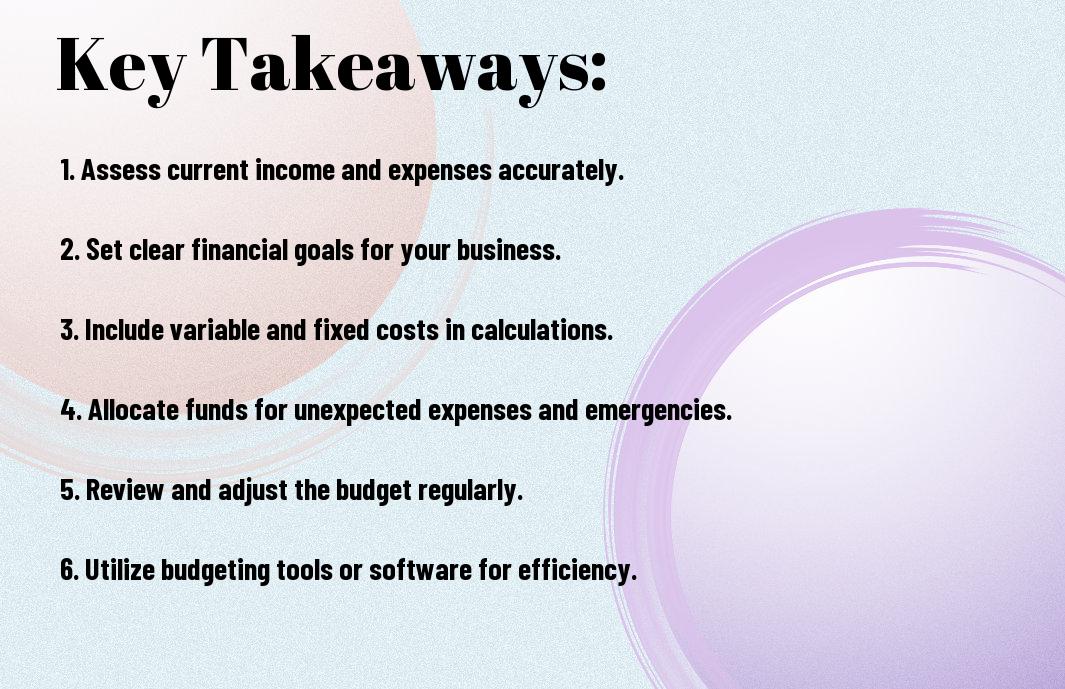Just like any successful venture, creating a realistic budget for your business is imperative for steering your enterprises toward growth and stability. You need to assess your revenue, track your expenses, and set realistic financial goals to ensure you make informed decisions. For a comprehensive guide, check out How to Create a Business Budget: 6 Simple Steps. This post will provide you with the practical steps to craft a budget that aligns with your business objectives.
Key Takeaways:
- Assess Your Financial Situation: Begin by gathering all financial data, including income statements, balance sheets, and cash flow statements to understand the current status of your business.
- Set Clear Goals: Outline specific and measurable objectives for your business that will guide your budgeting process, such as reducing expenses or increasing revenue.
- Review and Adjust Regularly: Periodically evaluate your budget against actual performance, making necessary adjustments to remain aligned with changing business conditions.


Understanding Your Business Financials
The foundation of a realistic budget lies in your understanding of your business financials. This means delving into your income sources and expenses to get a comprehensive view of your financial landscape. By clearly understanding where your money is coming from and where it is going, you will be better equipped to create a budget that aligns with your business goals and supports sustainable growth.
Analyzing Income Sources
Between various streams of income, you should evaluate which ones contribute the most to your bottom line. Analyze sales channels, service offerings, and any additional revenue sources you may have. By tracking these, you can identify trends and areas for potential growth, ensuring you focus your efforts on the most lucrative aspects of your business.
Identifying Fixed and Variable Expenses
After analyzing income sources, it’s time to categorize your expenses into fixed and variable. This distinction helps clarify your financial commitments and allows for more effective budget planning. Fixed expenses, such as rent and salaries, remain constant, while variable expenses fluctuate based on your business activity.
Sources of expenses are vital to understand for effective budgeting. Fixed expenses are predictable costs crucial for running your business, while variable expenses can change month to month based on operational needs. Monitoring these will enable you to make informed decisions about discretionary spending and potential cost-cutting measures, ultimately leading to a more realistic and achievable budget.
Setting Clear Financial Goals
It is vital to define clear financial goals for your business, as they act as a roadmap for your budget and spending decisions. By setting specific, measurable objectives, you can better align your financial strategies and track your progress over time. These goals will not only guide your budget planning but also motivate your team towards achieving the desired outcomes, ensuring that everyone is on the same page in terms of financial priorities.
Short-term vs Long-term Goals
Clear distinctions between short-term and long-term goals are vital for your budgeting process. Short-term goals often focus on immediate revenue targets or cost reductions within a year, while long-term goals may involve larger investments or expansion plans that span multiple years. Balancing both types of goals allows you to create a budget that addresses your immediate needs without forsaking future growth opportunities.
Establishing Key Performance Indicators (KPIs)
Below are some critical steps to help you establish effective Key Performance Indicators (KPIs) that can measure your financial progress. By selecting the right KPIs, you will be able to assess the health of your business regularly and make strategic adjustments when necessary.
Another important aspect of establishing KPIs is ensuring they align with your specific business goals. For instance, consider metrics like profit margins, cash flow, and return on investment to evaluate your financial performance accurately. Monitor these indicators consistently to identify trends and areas needing improvement. Effective KPI tracking will empower you to make informed decisions and refine your budget allocation, ultimately leading to more decisive steps toward achieving your financial aspirations.
Creating Budget Categories
Keep your budget organized by establishing clear categories that reflect your business operations. These categories can include fixed costs, variable expenses, and savings for future investments. By categorizing your spending, you can more effectively manage your finances and identify areas that need adjustment. For further guidance, check out 6 Steps to a Better Business Budget.
Necessary vs Discretionary Spending
Necessary expenses are those you must incur to keep your business running, such as rent, utilities, and salaries. In contrast, discretionary spending includes non-important items like marketing promotions or office upgrades. Understanding the difference between these two types of spending helps you prioritize your resources and make informed decisions about where to cut costs when needed.
Allocating Resources Effectively
Around setting your budget categories, it’s important to allocate resources effectively to maximize your business’s potential. Regularly evaluate your spending patterns to ensure funds are directed towards areas that drive growth and efficiency. By monitoring your finances and adjusting allocations based on performance, you can enhance your operations and better achieve your overall business goals.
At the core of effective resource allocation is the understanding that not all expenses contribute equally to your business’s success. By analyzing past expenses and evaluating their impact on your bottom line, you can prioritize funding for initiatives that yield the highest returns. This continual reassessment will allow you to pivot as needed, ensuring you remain agile and responsive in an ever-changing market.
Estimating Revenue and Expenses
All successful budgets begin with a precise estimation of your revenue and expenses. By evaluating your business’s income streams and cost structures, you can paint a comprehensive picture of your financial landscape. This involves not only forecasting future earnings but also accounting for unavoidable costs, helping you make informed financial decisions that align with your business goals.
Historical Data Analysis
Below, you will find the value of analyzing past financial performance to inform your budgeting process. By reviewing previous revenue and expense figures, you can identify trends that help predict future financial outcomes. Establishing a baseline from historical data allows you to set more accurate targets and make adjustments as necessary, leading to a better alignment with your business objectives.
Seasonal Trends and Market Research
Among the factors influencing your revenue projections are seasonal trends and market research, which should be integrated into your budgeting strategy. Understanding the cyclical nature of your business can help you prepare for fluctuations in sales, allowing you to allocate resources more effectively.
With thorough market research, you can also gain insights into consumer behavior, industry benchmarks, and economic conditions. This information equips you to adapt your budgeting strategies to align with current market demands, including identifying peak periods for sales and potential downturns. By leveraging seasonal trends and comprehensive market analysis, your budget becomes a dynamic tool that navigates the complexities of your business environment.
Implementing the Budget
Despite thorough planning, implementing your budget requires ongoing attention and adaptability. You should regularly monitor your expenses and revenues to ensure they align with your budgetary guidelines. Adjustments may be necessary as you encounter unexpected financial challenges or opportunities, so stay flexible to refine your approach and make informed decisions as needed.
Communication with Stakeholders
At the core of successful budget implementation is effective communication with all stakeholders involved. By sharing your budget goals and progress updates, you foster a culture of accountability and collaboration within your team. This transparency not only encourages everyone to stay on track but also allows for valuable feedback that can enhance your budgeting process.
Using Budgeting Tools and Software
Any effective budgeting process today benefits significantly from technology, so consider utilizing budgeting tools and software to streamline your financial management. These resources provide organized data analysis, forecasting features, and real-time updates, making it easier for you to track your performance against your budget.
Consequently, employing budgeting tools and software not only improves your accuracy but also saves you time. With features like automated reporting and expense tracking, these tools help you visualize trends and identify areas for improvement. By integrating such technology into your budgeting process, you enhance your ability to make informed decisions, ensuring your business remains financially on track.
Monitoring and Adjusting Your Budget
To ensure your budget remains effective, you must continuously monitor its performance and make adjustments as necessary. Regular assessments will help you identify discrepancies between projected and actual expenditures, allowing you to adapt your financial strategies accordingly. Engaging in this proactive approach not only keeps you on track but also empowers you to respond to changing business conditions.
Regular Review Processes
Your regular reviews should be scheduled at consistent intervals, such as monthly or quarterly, to provide a clear picture of your financial landscape. This process involves assessing both income and expenses, comparing them to your initial budget, and identifying any variances. By maintaining a routine, you can spot trends early and make informed decisions that enhance your financial health.
Making Necessary Adjustments
At times, you may need to modify your budget based on your findings. This could involve reallocating funds from less critical areas to those that are underfunded or adjusting your revenue expectations. Addressing these shifts will help you stay aligned with your business goals and safeguard your financial viability.
Budget adjustments are integral to keeping your financial plan relevant. If certain expenses are higher than expected or new opportunities arise, you must reallocate resources to meet those changes. Likewise, if revenue dips, you may need to cut back on certain expenditures. By staying flexible and open to change, you position your business for long-term success despite the challenges that may arise.
Conclusion
The process of creating a realistic budget for your business involves careful assessment, planning, and ongoing evaluation. You should gather accurate financial data, project your income and expenses, and be prepared to adjust your budget as circumstances change. By setting clear financial goals and regularly monitoring your performance against your budget, you empower yourself to make informed decisions that support your business’s growth and sustainability. Taking these steps will help ensure that your financial strategy aligns with your overall business objectives.
Q: What are the first steps in creating a realistic budget for my business?
A: To create a realistic budget, start by gathering all your financial statements, including income statements, cash flow statements, and balance sheets. Next, identify fixed and variable expenses necessary for your operations. Consider your expected income based on past sales and market research. Finally, categorize your expenses into necessary and discretionary to help prioritize spending. This structured approach will provide a clear overview of your financial landscape.
Q: How can I project my business income accurately?
A: Projecting income accurately involves analyzing historical sales data, market trends, and seasonal fluctuations. Use this data to identify patterns and trends. Consider external factors, such as economic conditions and competition, that may influence your sales. It’s also advisable to consult industry benchmarks to gauge your expectations against competitors. Creating multiple scenarios (optimistic, realistic, and pessimistic) can help you prepare for various market conditions.
Q: What tools can help me in the budgeting process?
A: There are several tools available to assist with budgeting, including spreadsheet software like Microsoft Excel or Google Sheets, which allows for customizable budget templates. Additionally, accounting software like QuickBooks or FreshBooks can automate many budgeting tasks and provide accurate financial reports. For more advanced needs, consider budgeting software such as Adaptive Insights or PlanGuru, which offer features tailored for business forecasting and analysis.


